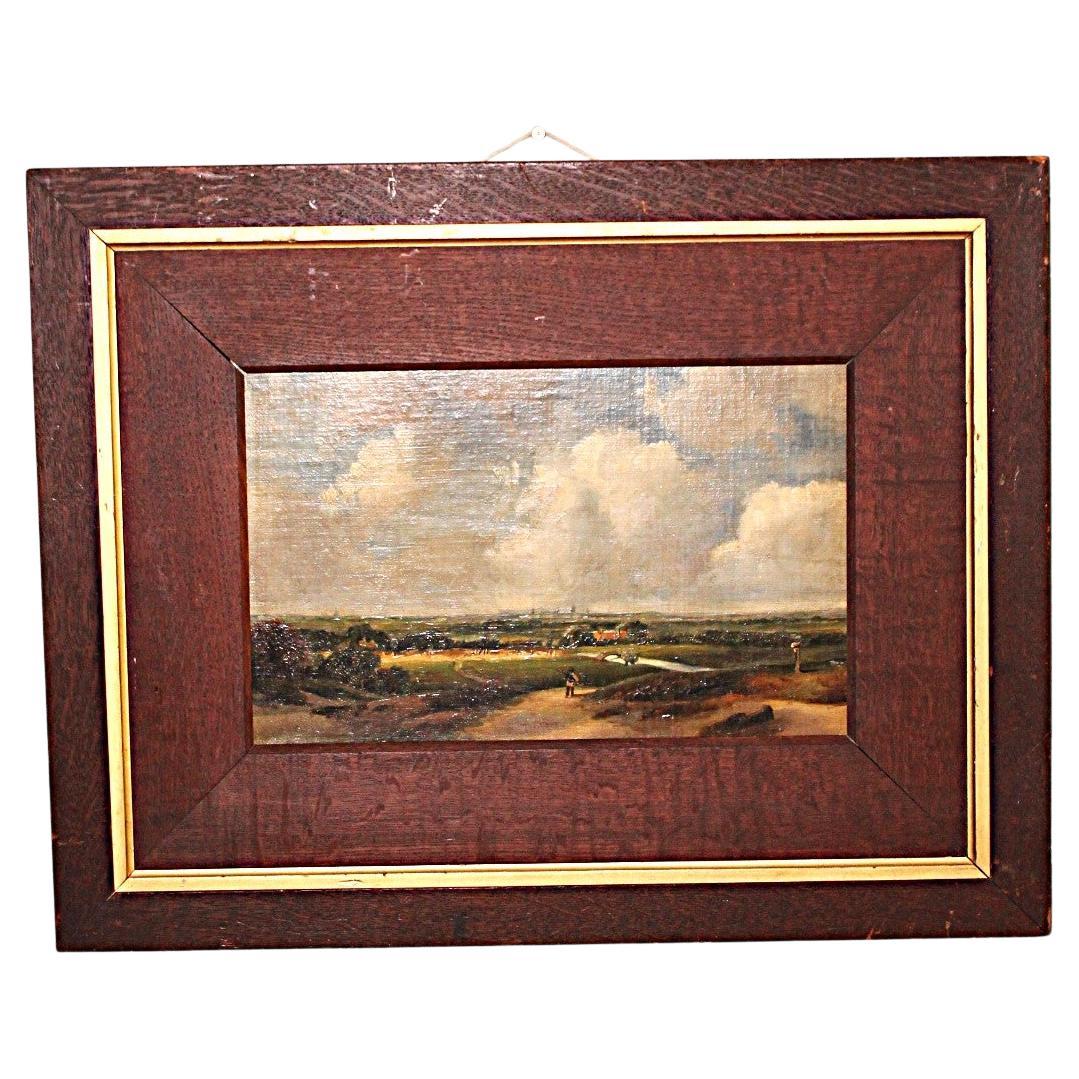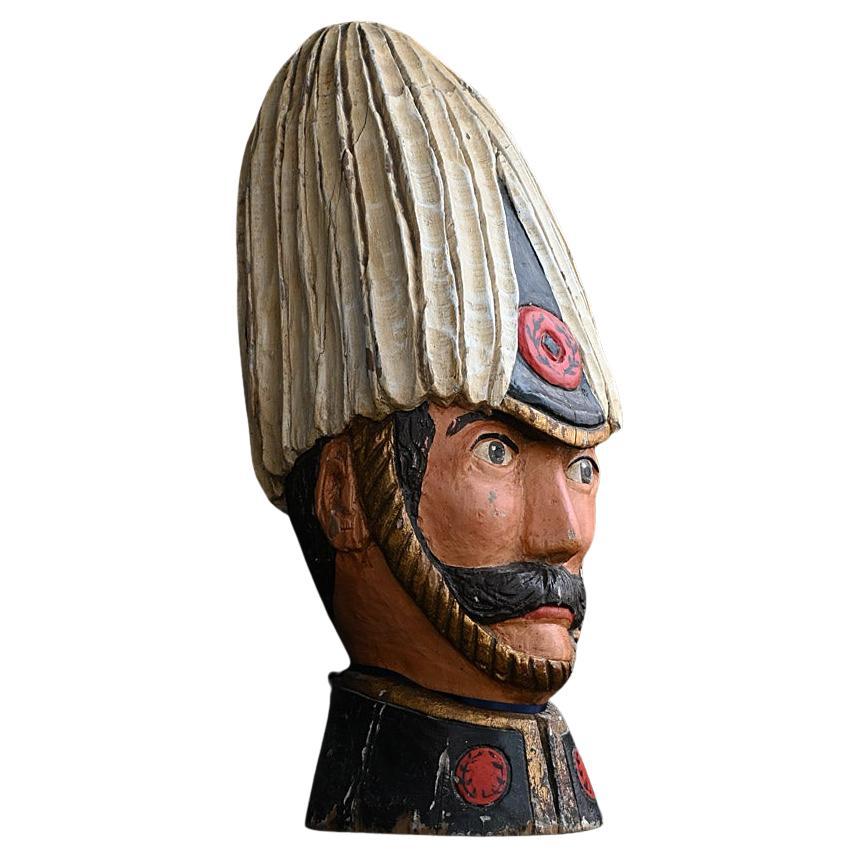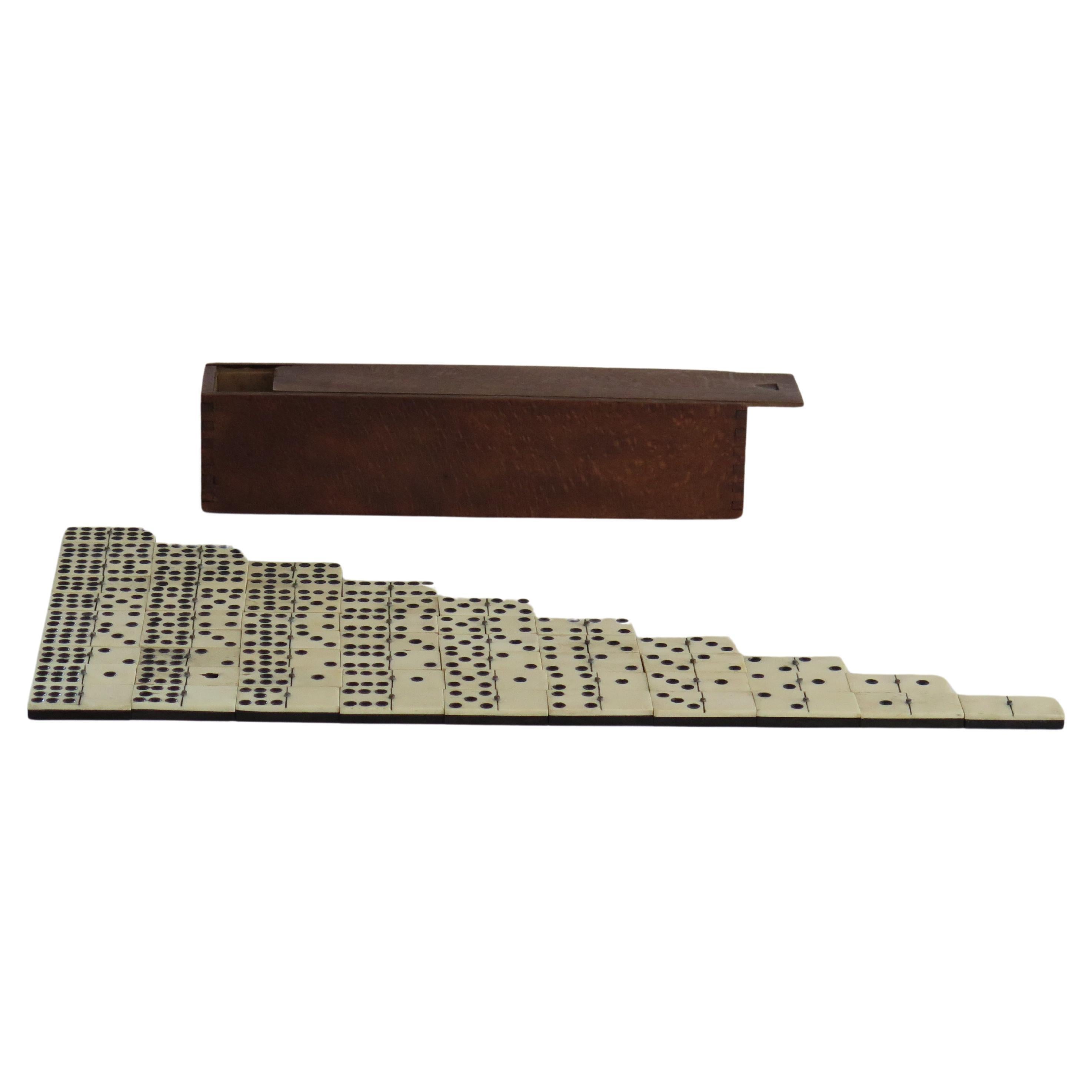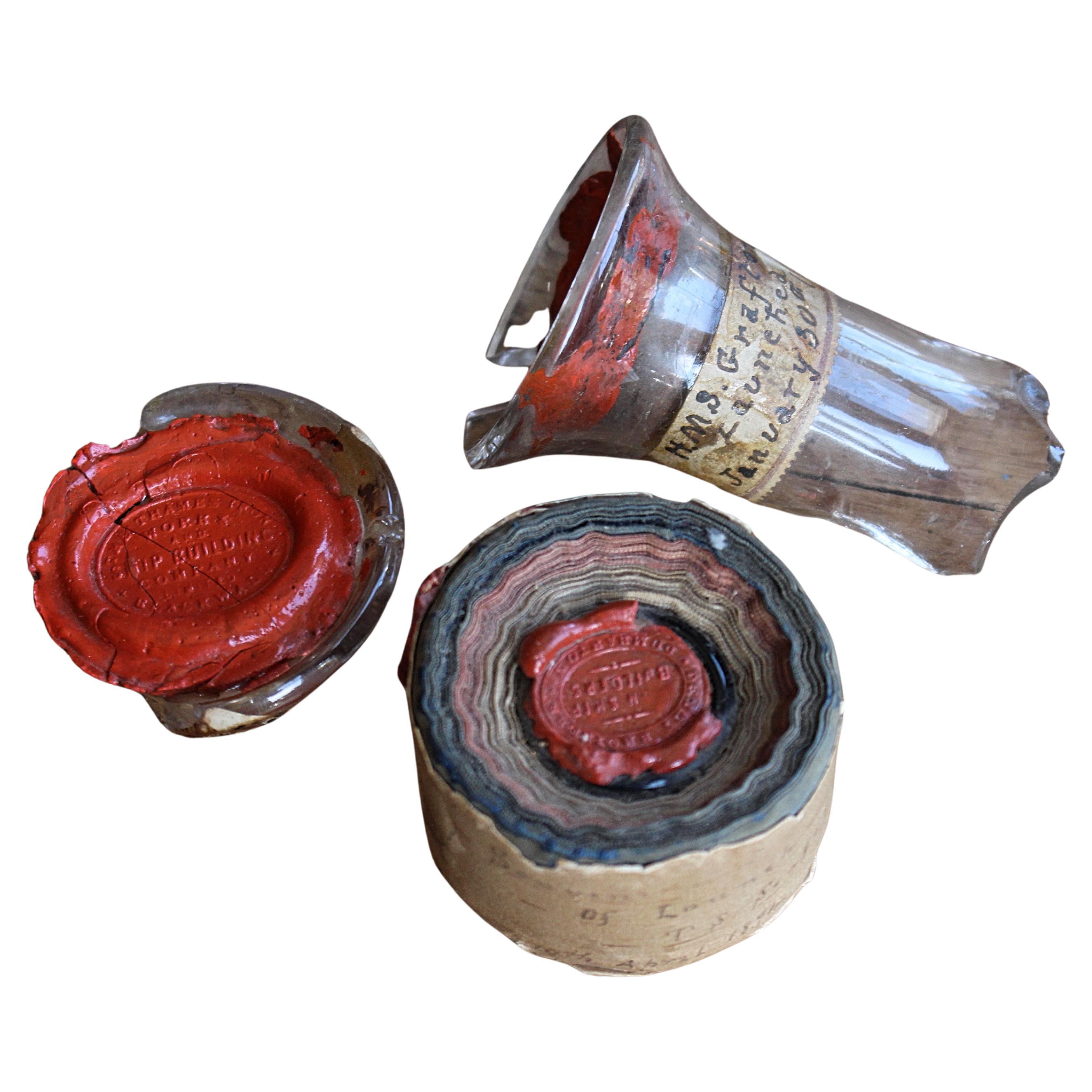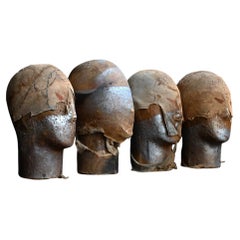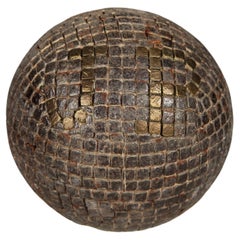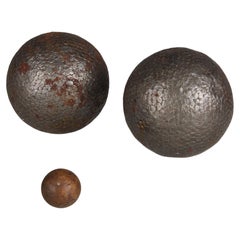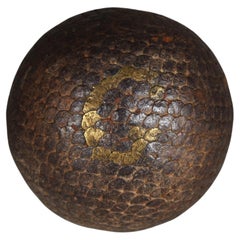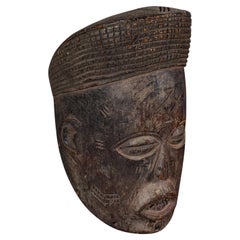Late Victorian Folk Art
to
5
53
5
59
2,013
1,062
605
254
201
188
161
94
88
76
56
41
36
30
22
20
50
9
7
2
2
1
3
2
45
31
30
29
8
52
35
14
8
4
59
59
59
1
1
Style: Late Victorian
Set of 4 Early 20th Century Hat Makers Heads
Located in London, GB
Set of 4 Early 20th Century Hat Makers Heads
Made from Papier Mache and supported by pine wooden blocks at the base, these highly unusual or even macabre hat makers forms have most ...
Category
1930s British Vintage Late Victorian Folk Art
Materials
Paper
Antique Boule Ball "J P", Pétanque, 1880s, France, Craftsmanship
Located in Greven, DE
Beautiful, unique Boule ball, France, late 19th Century.
In the 19th century, the manufacture of boules balls underwent significant development in France as the game of boules, part...
Category
Late 19th Century French Antique Late Victorian Folk Art
Materials
Metal, Brass
Pair Of Antique Boule Balls, Pétanque, 1880s, France, Craftsmanship
Located in Greven, DE
Beautiful, unique Boule ball pair and one target ball, France, late 19th Century.
In the 19th century, the manufacture of boules balls underwent significant development in France as...
Category
Late 19th Century French Antique Late Victorian Folk Art
Materials
Metal
Antique Boule Ball "G", Pétanque, 1880s, France, Craftsmanship
Located in Greven, DE
Beautiful, unique Boule ball, France, late 19th Century.
In the 19th century, the manufacture of boules balls underwent significant development in France as the game of boules, particularly the pétanque variant, gained in popularity. The manufacture of boules balls during this period was a manual process that required expertise, precision and love to detail.
In the late 19th and early 20th centuries, particularly in rural areas of France and other Mediterranean regions, olive wood was a commonly used source of material for making boules balls. This was not only due to the availability of the material, but also to the outstanding properties of olive wood, which was characterized by hardness, strength and a rich grain.
First, the olive wood was carefully selected and shaped into raw balls, which were then sanded to the desired size and shape. The nails were then hammered into the balls one by one, making sure that they were evenly distributed and firmly anchored. Finally, the spheres were polished and coated with a protective varnish to enhance their natural beauty and protect them from the elements.
The use of nails to decorate and reinforce olive wood boules was a traditional practice that not only gave the ball a rustic aesthetic, but also improved its durability and contributed to customization. Many balls were made according to the specific requirements and preferences of the players. Nails were driven at regular intervals around the ball, with each nail hole precisely placed so as not to affect the balance and weight distribution of the ball. These nails not only served as a decorative element, but also helped to strengthen the structure of the ball and make it more resistant to the hard knocks and wear and tear during play. Individual engravings or decorations were often applied to the balls to make them unique and identify the player.
Antique boules...
Category
Late 19th Century French Antique Late Victorian Folk Art
Materials
Metal
Antique Chokwe Mask, Central African, Carved Hardwood, Tribal, Victorian, C.1900
Located in Hele, Devon, GB
This is an antique Chokwe mask. A Central African, carved hardwood tribal face mask, dating to the late Victorian period, circa 1900.
Fascinating t...
Category
Late 19th Century African Antique Late Victorian Folk Art
Materials
Hardwood
19th C Folk Art J.Wheatley Jones Oil on Board Dog & Interior "Inferno" 1887
Located in Lowestoft, GB
A charming oil on board painting of a pondering dog in a country house kitchen. Age related craquelure to the painted surface, the odd knock and abrasion to the gilt gesso frame. But...
Category
Late 19th Century English Antique Late Victorian Folk Art
Materials
Canvas, Pine
J. Alden Weir Hand Made Studio Sign Branchville Connecticut
Located in Garnerville, NY
Recently purchased from a multi-generational Ridgefield, CT estate of the former President of Ridgefield Savings Bank. Our esteemed and avid collector found time in his off hours in Post World War II Connecticut to scour the countryside for just about anything that struck his fancy. He had an enormous passion for model trains, porcelain figurines and pattern Depression Era glass...
Category
Late 19th Century American Antique Late Victorian Folk Art
Materials
Iron
$2,240 Sale Price
20% Off
Late 19th Century "9-Spot" Dominoe Game 55 Piece Set in Jointed Hardwood Box
Located in Lincoln, Lincolnshire
This is a rare and original '9 Spot' Dominoe game of 55 individual dominoes, coming complete with its jointed wooden box or case.
Dominoe sets are normally six-spot sets giving a to...
Category
Late 19th Century English Antique Late Victorian Folk Art
Materials
Bone, Wood
Late 19th C Memento Mori Calligraphy In memory of Maria Arthur Manchip Died 1899
Located in Lowestoft, GB
A fantastically decorative pen and ink calligraphy composition celebrating the life of a Maria Arthur Manchip who dies 1899.
On paper, in a gl...
Category
Late 19th Century English Antique Late Victorian Folk Art
Materials
Glass, Wood, Paper
Late 19th Century Original Painted Green Faux Marble Dog Canine Kennel
Located in Lowestoft, GB
A charming painted wooden dog kennel with pitched roof standing on styled feet.
The original green painted body, with a faux marble painted pediment and red roof. The pediment als...
Category
Late 19th Century English Antique Late Victorian Folk Art
Materials
Pine
Antique Decorative Lead Plaque, Scandinavian, Viking, Arts and Crafts, Victorian
Located in Hele, Devon, GB
This is a heavy antique decorative lead plaque. A Scandinavian, relief panel with Viking long ship scene, dating to the Arts & Crafts movement of the late ...
Category
Late 19th Century Scandinavian Antique Late Victorian Folk Art
Materials
Lead
Early 20th century double sided English chemist sign
Located in London, GB
Early 20th century double sided English chemist sign
Made from double sided glass with reflective silver illuminated text, this early 20th century example of an English chemist tra...
Category
1930s British Vintage Late Victorian Folk Art
Materials
Metal
Antique Boule Ball "C" With Star Decor, Pétanque, 1880s, France, Craftsmanship
Located in Greven, DE
Beautiful, unique Boule ball, France, late 19th Century.
In the 19th century, the manufacture of boules balls underwent significant development in France as the game of boules, part...
Category
Late 19th Century French Antique Late Victorian Folk Art
Materials
Metal, Brass
Antique Boule Set, Boule Balls, Pétanque, 1880s, France, Craftsmanship
Located in Greven, DE
Beautiful, unique Boule set of three Boule balls and one target ball, France, late 19th century.
In the 19th century, the manufacture of boule balls underwent significant developmen...
Category
Late 19th Century French Antique Late Victorian Folk Art
Materials
Olive
Silk Embroidered Hand Painted Seascape by Thomas Willis, circa 1890
Located in Nantucket, MA
19th century silk embroidered and hand painted oil on canvas seascape by Thomas Willis (1850 - 1925), depicting a schooner-rigged racing yacht closely ha...
Category
1890s American Antique Late Victorian Folk Art
Materials
Canvas, Silk
Antique American Figural Painted Copper Horse Weatherwane with Cast Directional
Located in Hamilton, Ontario
This figural antique weathervane is usigned, but presumed to have originated from the United States and date to approximately 1880 and done in the...
Category
Late 19th Century American Antique Late Victorian Folk Art
Materials
Copper, Iron
Classical Walking Stick in Ebonized Walnut & Sterling Pommel w/ Heraldic Crest
Located in New York, NY
This Classical Walking Stick in Ebonized Walnut & Sterling Pommel W/ Heraldic Crest originates from France during the Late 19th Century. Features a elegant and timeless profile with ...
Category
Late 19th Century French Antique Late Victorian Folk Art
Materials
Sterling Silver
PAIR OF CIRCA 1890 ORiGINAL PAINT NEW OLD STOCK CRATED FAIRGROUND RIDE HORSES
Located in West Sussex, Pulborough
Royal House Antiques
Royal House Antiques is delighted to offer for sale this absolutely exquisite pair of new old stock Fairground ride horses
Please note the delivery fee listed ...
Category
1890s Antique Late Victorian Folk Art
Materials
Wood
$4,068 Sale Price / set
40% Off
Antique Boule Set, Boule Balls, Pétanque, 1880s, France, Craftsmanship
Located in Greven, DE
Beautiful, unique Boule set of three Boule balls and one target ball, France, late 19th Century.
Fantastic colour and patina!
In the 19th century, antique metal boules balls experienced a renaissance that took the game of boules to a new level.
These ornately crafted balls were not only instruments of the game, but also symbols of elegance and sophistication in leisure activities.
Made from high-quality metals such as steel or brass, Boule balls were forged and polished by skilled craftsmen to ensure a smooth and even surface.
The antique boules...
Category
Late 19th Century French Antique Late Victorian Folk Art
Materials
Metal
Antique Boule Set, Boule Balls, Pétanque, 1880s, France, Craftsmanship
Located in Greven, DE
Beautiful, unique Boule set of three Boule balls, France, late 19th century.
In the 19th century, antique metal boules balls experienced a renaissance that took the game of boules to a new level.
These ornately crafted balls were not only instruments of the game, but also symbols of elegance and sophistication in leisure activities.
Made from high-quality metals such as steel or brass, Boule balls were forged and polished by skilled craftsmen to ensure a smooth and even surface.
The antique boules...
Category
Late 19th Century French Antique Late Victorian Folk Art
Materials
Metal
Antique Franz Bergman Vienna Cold Painted Bronze Cobra Snake Statue Watch Holder
Located in West Sussex, Pulborough
We are delighted to offer for sale this stunning original Circa 1900 Austrian Vienna cold paint bronze Statue / Watch holder by the wonder that is Franz Bergman.
Fully stamped to ...
Category
Early 1900s Italian Antique Late Victorian Folk Art
Materials
Bronze
$6,232 Sale Price
30% Off
Victorian "9-Spot" Dominoe Game 55 Piece Set in Jointed Hardwood Box, 19th C.
Located in Lincoln, Lincolnshire
This is a rare and original '9 Spot' Dominoe game of 55 individual dominoes, coming complete with its jointed wooden box or case.
Dominoe sets are normally six-spot sets giving a to...
Category
Late 19th Century English Antique Late Victorian Folk Art
Materials
Bone, Wood
Large Set Of Antique Boule Balls, 13 Pieces, Pétanque, 1880s, France
Located in Greven, DE
Large Boule ball set of 13 pieces, France, late 19th Century.
Unrestored, original condition with signs of age and use.
In the 19th century, the manufacture of boules balls underwen...
Category
Late 19th Century French Antique Late Victorian Folk Art
Materials
Metal, Copper, Steel
Antique Boule Set, Boule Balls, Pétanque, 1880s, France, Craftsmanship
Located in Greven, DE
Beautiful, unique Boule set of three Boule balls and one target ball, France, late 19th Century.
Diameter 8,5 cm.
Fantastic colour and patina!
In the 19th century, antique metal boules balls experienced a renaissance that took the game of boules to a new level.
These ornately crafted balls were not only instruments of the game, but also symbols of elegance and sophistication in leisure activities.
Made from high-quality metals such as steel or brass, Boule balls were forged and polished by skilled craftsmen to ensure a smooth and even surface.
The antique boules...
Category
Late 19th Century French Antique Late Victorian Folk Art
Materials
Metal
Complete Set Of Antique Boule Balls, 8 Pieces, Pétanque, 1880s, France
Located in Greven, DE
Complete Boule ball set of 8 pieces, France, late 19th Century.
In the 19th century, the manufacture of boules balls underwent significant development in France as the game of boule...
Category
Late 19th Century French Antique Late Victorian Folk Art
Materials
Metal
Pair Of Antique Boule Balls "3", "V", Pétanque, 1880s, France, Craftsmanship
Located in Greven, DE
Beautiful, unique Boule ball pair, France, late 19th Century.
Decorated with the numer "3" on each ball and with a "V" on one of the Boule balls.
In the 19th century, the manufactur...
Category
Late 19th Century French Antique Late Victorian Folk Art
Materials
Olive
Antique Boule Balls Set "B", Pétanque, 1880s, France, Craftsmanship
Located in Greven, DE
Beautiful, unique Boule set of three Boule balls, France, late 19th Century.
In the 19th century, the manufacture of boules balls underwent significant development in France as the game of boules, particularly the pétanque variant, gained in popularity. The manufacture of boules balls during this period was a manual process that required expertise, precision and love to detail.
In the late 19th and early 20th centuries, particularly in rural areas of France and other Mediterranean regions, olive wood was a commonly used source of material for making boules balls. This was not only due to the availability of the material, but also to the outstanding properties of olive wood, which was characterized by hardness, strength and a rich grain.
First, the olive wood was carefully selected and shaped into raw balls, which were then sanded to the desired size and shape. The nails were then hammered into the balls one by one, making sure that they were evenly distributed and firmly anchored. Finally, the spheres were polished and coated with a protective varnish to enhance their natural beauty and protect them from the elements.
The use of nails to decorate and reinforce olive wood boules was a traditional practice that not only gave the ball a rustic aesthetic, but also improved its durability and contributed to customization. Many balls were made according to the specific requirements and preferences of the players. Nails were driven at regular intervals around the ball, with each nail hole precisely placed so as not to affect the balance and weight distribution of the ball. These nails not only served as a decorative element, but also helped to strengthen the structure of the ball and make it more resistant to the hard knocks and wear and tear during play. Individual engravings or decorations were often applied to the balls to make them unique and identify the player.
Antique boules...
Category
Late 19th Century French Antique Late Victorian Folk Art
Materials
Olive
William Gordon Burn-Murdoch (British, 1862 - 1939) European Street Scene
Located in Philadelphia, PA
William Gordon Burn-Murdoch (British, 1862 - 1939) Busy European Street Scene with horse drawn carriage, many people, oil on canvas, signed lower left W.G. Burn-Murdoch circa 1902, ...
Category
Early 20th Century British Late Victorian Folk Art
Materials
Canvas, Paint
Antique Boule Ball "17", Pétanque, 1880s, France, Craftsmanship
Located in Greven, DE
Beautiful, unique Boule ball, France, late 19th Century.
In the 19th century, the manufacture of boules balls underwent significant development in France as the game of boules, part...
Category
Late 19th Century French Antique Late Victorian Folk Art
Materials
Metal
Antique Boule Ball "P A", Pétanque, 1880s, France, Craftsmanship
Located in Greven, DE
Beautiful, unique Boule ball, France, late 19th Century.
In the 19th century, the manufacture of boules balls underwent significant development in France as the game of boules, part...
Category
Late 19th Century French Antique Late Victorian Folk Art
Materials
Metal
Pair Of Antique Boule Balls "3", Pétanque, 1880s, France, Craftsmanship
Located in Greven, DE
Beautiful, unique Boule ball pair and one target ball, France, late 19th Century.
Decorated with the numer "3" on each of the Boule balls.
In the 19th century, the manufacture of b...
Category
Late 19th Century French Antique Late Victorian Folk Art
Materials
Olive
Antique Boule Balls Set "B", Pétanque, 1880s, France, Craftsmanship
Located in Greven, DE
Beautiful, unique Boule set of three Boule balls and one target ball, France, late 19th century.
In the 19th century, the manufacture of boules balls underwent significant development in France as the game of boules, particularly the pétanque variant, gained in popularity. The manufacture of boules balls during this period was a manual process that required expertise, precision and love to detail.
In the late 19th and early 20th centuries, particularly in rural areas of France and other Mediterranean regions, olive wood was a commonly used source of material for making boules balls. This was not only due to the availability of the material, but also to the outstanding properties of olive wood, which was characterized by hardness, strength and a rich grain.
First, the olive wood was carefully selected and shaped into raw balls, which were then sanded to the desired size and shape. The nails were then hammered into the balls one by one, making sure that they were evenly distributed and firmly anchored. Finally, the spheres were polished and coated with a protective varnish to enhance their natural beauty and protect them from the elements.
The use of nails to decorate and reinforce olive wood boules was a traditional practice that not only gave the ball a rustic aesthetic, but also improved its durability and contributed to customization. Many balls were made according to the specific requirements and preferences of the players. Nails were driven at regular intervals around the ball, with each nail hole precisely placed so as not to affect the balance and weight distribution of the ball. These nails not only served as a decorative element, but also helped to strengthen the structure of the ball and make it more resistant to the hard knocks and wear and tear during play. Individual engravings or decorations were often applied to the balls to make them unique and identify the player.
Antique boules...
Category
Late 19th Century French Antique Late Victorian Folk Art
Materials
Olive
19th Century Maritime Curiosities Launch Bottle Shards Naval Sailors
Located in Lowestoft, GB
Trio of 19th century maritime curiositys, two glass bottle neck shards from the launch bottles of two ships. Also an unused streamer from another ships maiden voyage All have the wax...
Category
19th Century English Antique Late Victorian Folk Art
Materials
Glass, Paper
Antique 19th Century English Glazed Ceramic And Brass Fireplace Tool Rest
Located in Greven, DE
This eye-catching English antique is a fireplace tool rest - a desirable and common feature in Victorian homes. As the name suggests, its purpose is to hold fireplace tools such as b...
Category
Late 19th Century English Antique Late Victorian Folk Art
Materials
Brass
Antique Boule Ball, Pétanque, 1880s, France, Craftsmanship
Located in Greven, DE
Beautiful, unique Boule ball, France, late 19th Century.
In the 19th century, the manufacture of boules balls underwent significant development in France as the game of boules, part...
Category
Late 19th Century French Antique Late Victorian Folk Art
Materials
Metal
Antique Boule Ball "B", Pétanque, 1880s, France, Craftsmanship
Located in Greven, DE
Beautiful, unique Boule ball, France, late 19th Century.
In the 19th century, the manufacture of boules balls underwent significant development in France as the game of boules, part...
Category
Late 19th Century French Antique Late Victorian Folk Art
Materials
Metal
Antique Boule Ball "D F", Pétanque, 1880s, France, Craftsmanship
Located in Greven, DE
Beautiful, unique Boule ball, France, late 19th Century.
In the 19th century, the manufacture of boules balls underwent significant development in France as the game of boules, part...
Category
Late 19th Century French Antique Late Victorian Folk Art
Materials
Metal, Brass
Pair Of Antique Boule Balls "4", Pétanque, 1880s, France, Craftsmanship
Located in Greven, DE
Beautiful, unique Boule ball pair, France, late 19th Century.
Diameter 9,4 cm.
In the 19th century, the manufacture of boules balls underwent significant development in France as th...
Category
Late 19th Century French Antique Late Victorian Folk Art
Materials
Olive
Antique Boule Balls Set "9", Pétanque, 1880s, France, Craftsmanship
Located in Greven, DE
Beautiful, unique Boule set of three Boule balls and one target ball, France, late 19th century.
In the 19th century, the manufacture of boules balls underwent significant development in France as the game of boules, particularly the pétanque variant, gained in popularity. The manufacture of boules balls during this period was a manual process that required expertise, precision and love to detail.
In the late 19th and early 20th centuries, particularly in rural areas of France and other Mediterranean regions, olive wood was a commonly used source of material for making boules balls. This was not only due to the availability of the material, but also to the outstanding properties of olive wood, which was characterized by hardness, strength and a rich grain.
First, the olive wood was carefully selected and shaped into raw balls, which were then sanded to the desired size and shape. The nails were then hammered into the balls one by one, making sure that they were evenly distributed and firmly anchored. Finally, the spheres were polished and coated with a protective varnish to enhance their natural beauty and protect them from the elements.
The use of nails to decorate and reinforce olive wood boules was a traditional practice that not only gave the ball a rustic aesthetic, but also improved its durability and contributed to customization. Many balls were made according to the specific requirements and preferences of the players. Nails were driven at regular intervals around the ball, with each nail hole precisely placed so as not to affect the balance and weight distribution of the ball. These nails not only served as a decorative element, but also helped to strengthen the structure of the ball and make it more resistant to the hard knocks and wear and tear during play. Individual engravings or decorations were often applied to the balls to make them unique and identify the player.
Antique boules...
Category
Late 19th Century French Antique Late Victorian Folk Art
Materials
Olive
Antique Boule Ball "G", "J", Pétanque, 1880s, France, Craftsmanship
Located in Greven, DE
Beautiful, unique Boule ball, France, late 19th Century.
Decorated with the initials "G" and "J".
In the 19th century, the manufacture of boules balls underwent significant developm...
Category
Late 19th Century French Antique Late Victorian Folk Art
Materials
Olive
Antique Boule Ball "62", Pétanque, 1880s, France, Craftsmanship
Located in Greven, DE
Beautiful, unique Boule ball, France, late 19th Century.
In the 19th century, the manufacture of boules balls underwent significant development in France as the game of boules, part...
Category
Late 19th Century French Antique Late Victorian Folk Art
Materials
Metal
Pair Of Antique Boule Balls "G", Pétanque, 1880s, France, Craftsmanship
Located in Greven, DE
Beautiful, unique Boule ball pair, France, late 19th Century.
In the 19th century, the manufacture of boules balls underwent significant development in France as the game of boules,...
Category
Late 19th Century French Antique Late Victorian Folk Art
Materials
Olive
Antique Boule Ball "G", Pétanque, 1880s, France, Craftsmanship
Located in Greven, DE
Beautiful, unique Boule ball, France, late 19th Century.
In the 19th century, the manufacture of boules balls underwent significant development in France as the game of boules, particularly the pétanque variant, gained in popularity. The manufacture of boules balls during this period was a manual process that required expertise, precision and love to detail.
In the late 19th and early 20th centuries, particularly in rural areas of France and other Mediterranean regions, olive wood was a commonly used source of material for making boules balls. This was not only due to the availability of the material, but also to the outstanding properties of olive wood, which was characterized by hardness, strength and a rich grain.
First, the olive wood was carefully selected and shaped into raw balls, which were then sanded to the desired size and shape. The nails were then hammered into the balls one by one, making sure that they were evenly distributed and firmly anchored. Finally, the spheres were polished and coated with a protective varnish to enhance their natural beauty and protect them from the elements.
The use of nails to decorate and reinforce olive wood boules was a traditional practice that not only gave the ball a rustic aesthetic, but also improved its durability and contributed to customization. Many balls were made according to the specific requirements and preferences of the players. Nails were driven at regular intervals around the ball, with each nail hole precisely placed so as not to affect the balance and weight distribution of the ball. These nails not only served as a decorative element, but also helped to strengthen the structure of the ball and make it more resistant to the hard knocks and wear and tear during play. Individual engravings or decorations were often applied to the balls to make them unique and identify the player.
Antique boules...
Category
Late 19th Century French Antique Late Victorian Folk Art
Materials
Metal
Antique Boule Ball With Star Decor And C, Pétanque, 1880s, France, Craftsmanship
Located in Greven, DE
Beautiful, unique Boule ball, France, late 19th Century.
In the 19th century, the manufacture of boules balls underwent significant development in France as the game of boules, part...
Category
Late 19th Century French Antique Late Victorian Folk Art
Materials
Metal, Brass
Antique Boule Ball "7", Pétanque, 1880s, France, Craftsmanship
Located in Greven, DE
Beautiful, unique Boule ball, France, late 19th Century.
In the 19th century, the manufacture of boules balls underwent significant development in France as the game of boules, particularly the pétanque variant, gained in popularity. The manufacture of boules balls during this period was a manual process that required expertise, precision and love to detail.
In the late 19th and early 20th centuries, particularly in rural areas of France and other Mediterranean regions, olive wood was a commonly used source of material for making boules balls. This was not only due to the availability of the material, but also to the outstanding properties of olive wood, which was characterized by hardness, strength and a rich grain.
First, the olive wood was carefully selected and shaped into raw balls, which were then sanded to the desired size and shape. The nails were then hammered into the balls one by one, making sure that they were evenly distributed and firmly anchored. Finally, the spheres were polished and coated with a protective varnish to enhance their natural beauty and protect them from the elements.
The use of nails to decorate and reinforce olive wood boules was a traditional practice that not only gave the ball a rustic aesthetic, but also improved its durability and contributed to customization. Many balls were made according to the specific requirements and preferences of the players. Nails were driven at regular intervals around the ball, with each nail hole precisely placed so as not to affect the balance and weight distribution of the ball. These nails not only served as a decorative element, but also helped to strengthen the structure of the ball and make it more resistant to the hard knocks and wear and tear during play. Individual engravings or decorations were often applied to the balls to make them unique and identify the player.
Antique boules...
Category
Late 19th Century French Antique Late Victorian Folk Art
Materials
Metal
Pair Of Antique Boule Balls, Pétanque, 1880s, France, Craftsmanship
Located in Greven, DE
Beautiful, unique Boule ball pair, France, late 19th Century.
Diameter 9,5 cm.
In the 19th century, the manufacture of boules balls underwent significant development in France as the game of boules, particularly the pétanque variant, gained in popularity. The manufacture of boules balls during this period was a manual process that required expertise, precision and love to detail.
In the late 19th and early 20th centuries, particularly in rural areas of France and other Mediterranean regions, olive wood was a commonly used source of material for making boules balls. This was not only due to the availability of the material, but also to the outstanding properties of olive wood, which was characterized by hardness, strength and a rich grain.
First, the olive wood was carefully selected and shaped into raw balls, which were then sanded to the desired size and shape. The nails were then hammered into the balls one by one, making sure that they were evenly distributed and firmly anchored. Finally, the spheres were polished and coated with a protective varnish to enhance their natural beauty and protect them from the elements.
The use of nails to decorate and reinforce olive wood boules was a traditional practice that not only gave the ball a rustic aesthetic, but also improved its durability and contributed to customization. Many balls were made according to the specific requirements and preferences of the players. Nails were driven at regular intervals around the ball, with each nail hole precisely placed so as not to affect the balance and weight distribution of the ball. These nails not only served as a decorative element, but also helped to strengthen the structure of the ball and make it more resistant to the hard knocks and wear and tear during play. Individual engravings or decorations were often applied to the balls to make them unique and identify the player.
Antique boules...
Category
Late 19th Century French Antique Late Victorian Folk Art
Materials
Olive
Pair Of Antique Boule Balls Circle, Pétanque, 1880s, France, Craftsmanship
Located in Greven, DE
Beautiful, unique Boule ball pair and one target ball, France, late 19th Century.
In the 19th century, the manufacture of boules balls underwent significant development in France as...
Category
Late 19th Century French Antique Late Victorian Folk Art
Materials
Olive
Early 20th Century English Hand Carved Fairground Fragments
Located in London, GB
Early 20th Century English Hand Carved Fairground Fragments
A closely matched pair of hand carved pine sectioned English fairground decorative fragments. Original paint still pres...
Category
1920s British Vintage Late Victorian Folk Art
Materials
Pine
Early 20th Century Auntie Sally English Parlour Game
Located in London, GB
Early 20th century Auntie Sally English parlour game
A rare early 20th Century example of an English hand-crafted Aunt Sally parlour game. Made from pine wood this item has 22 wooden throwing sticks, 1 aunt sally figure, several clay pipes...
Category
1920s British Vintage Late Victorian Folk Art
Materials
Pine
Antique Boule Ball Brass Decor, Pétanque, 1880s, France, Craftsmanship
Located in Greven, DE
Beautiful, unique Boule ball, France, late 19th Century.
In the 19th century, the manufacture of boules balls underwent significant development in France as the game of boules, part...
Category
Late 19th Century French Antique Late Victorian Folk Art
Materials
Metal, Brass
Antique Boule Ball "6", Pétanque, 1880s, France, Craftsmanship
Located in Greven, DE
Beautiful, unique Boule ball, France, late 19th Century.
In the 19th century, the manufacture of boules balls underwent significant development in France as the game of boules, part...
Category
Late 19th Century French Antique Late Victorian Folk Art
Materials
Metal, Brass
Late 19th Century Portrait Decorated Game Board
Located in Nantucket, MA
Late 19th century hand made and decoratively painted game board, circa 1890s to 1910, a checker or chess board with squares individually hand painted with miniature watercolor portra...
Category
Late 19th Century American Antique Late Victorian Folk Art
Materials
Wood
Early 20th Century Double Sided Toleware French Dentists Trade Sign
Located in London, GB
Early 20th Century Double Sided Toleware French Dentists Trade Sign
An original untouched example of an early 20th Century toleware double sided Frenc...
Category
1910s French Vintage Late Victorian Folk Art
Materials
Sheet Metal
Antique Boule Ball With Flower Decor, Pétanque, 1880s, France, Craftsmanship
Located in Greven, DE
Beautiful, unique Boule ball, France, late 19th Century.
In the 19th century, the manufacture of boules balls underwent significant development in France as the game of boules, part...
Category
Late 19th Century French Antique Late Victorian Folk Art
Materials
Metal, Brass
Pair Of Antique Boule Balls "24", Pétanque, 1880s, France, Craftsmanship
Located in Greven, DE
Beautiful, unique Boule ball pair and one target ball, France, late 19th Century.
In the 19th century, the manufacture of boules balls underwent significant development in France as...
Category
Late 19th Century French Antique Late Victorian Folk Art
Materials
Olive
Circa 1900 English fairground hand carved timber bust
Located in London, GB
Circa 1900 English fairground hand carved timber bust
An important piece of fairground history, in the form of a circa 1900 English fairground carved fragment of Field Marshal Hora...
Category
1920s British Vintage Late Victorian Folk Art
Materials
Wood
French Weathered Stone Statue of a Sleeping Putti, Baby Cherub with Wings
Located in Godshill, Isle of Wight
French weathered stone statue of a sleeping putti, baby cherub with wings
Sleeping in the sunshine with his head on his arms and dainty wings on h...
Category
Early 1900s Antique Late Victorian Folk Art
Materials
Cast Stone
Lovely Late Victorian circa 1880 Hand Carved Black Forest Wine Bottle Holder
By Black Forest
Located in West Sussex, Pulborough
We are delighted to offer for sale this absolutely lovely original circa 1880 Black forest carved wine bottle holder
A very good looking and decorative piece of folk art from the ...
Category
1880s German Antique Late Victorian Folk Art
Materials
Wood
$1,869 Sale Price
30% Off
Pair of 1894 Watercolour Paintings by H Brock Univited Guest, a Lion in the Path
Located in West Sussex, Pulborough
We are delighted to offer for sale this lovely pair of late Victorian watercolors signed H Brock and dated Apr 1894
The first is titled “An Uninvited Guest” and the second “A Lion...
Category
1890s English Antique Late Victorian Folk Art
Materials
Wood
$910 Sale Price / set
30% Off
Late Victorian folk art for sale on 1stDibs.
Find a broad range of unique Late Victorian folk art for sale on 1stDibs. Many of these items were first offered in the Mid-20th Century, but contemporary artisans have continued to produce works inspired by this style. If you’re looking to add vintage folk art created in this style to your space, the works available on 1stDibs include folk art, more furniture and collectibles, decorative objects and other home furnishings, frequently crafted with wood, metal and other materials. If you’re shopping for used Late Victorian folk art made in a specific country, there are Europe, United Kingdom, and England pieces for sale on 1stDibs. While there are many designers and brands associated with original folk art, popular names associated with this style include A. Lietz Co., Black Forest, and Franz Bergmann. It’s true that these talented designers have at times inspired knockoffs, but our experienced specialists have partnered with only top vetted sellers to offer authentic pieces that come with a buyer protection guarantee. Prices for folk art differ depending upon multiple factors, including designer, materials, construction methods, condition and provenance. On 1stDibs, the price for these items starts at $291 and tops out at $8,740 while the average work can sell for $1,560.
Recently Viewed
View AllMore Ways To Browse
George Washington Memorabilia
Mexican Drum
Parade Shield
34 Star Flag
39 Star American Flag
39 Star Flag
Antique Cotton Basket
Carved Ship Figurehead
Fertility Wooden Figure
Painted Pantry Boxes
Wood And Hide Drum
38 Star Flag
Antique Copper Rooster Weathervane
Antique Horse Weathervanes
Antique Native American Bow
Antique Weathervane Horse
Folk Art Whirligig
Native American Beaded Dress

